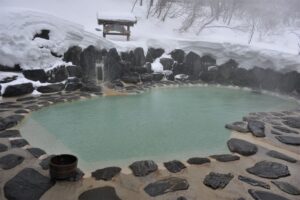
Seasons pass, as do calamities. Time marches on. But onsen hot springs are timeless, flowing since the early days of the Earth.
Perhaps the keepers of centuries-old traditional Japanese inns at hot springs are more keenly aware of these sentiments than the rest of us.
Such thoughts are worth contemplating amid the pleasant environment of a rotenburo alfresco bath to reinvigorate the mind, body and soul, especially in today’s convoluted world.
Lead photo: The mixed-bathing outdoor bath at Tsuru no Yu inn in Nyuto Onsen hamlet, Akita Prefecture
This too shall pass
Attributed to medieval Persian Sufi poets
The taxman
Perched at an elevation of 750 meters on Mt. Azuma, Takayu Onsen in Fukushima Prefecture is worth a visit because of its blue-tinged sulfur onsen hot spring water and 400-year history.
Takayu Onsen is blessed with nearly 3,000 liters of onsen water per minute emanating from nine different springs at 42 to 50 degrees Celsius, which is more than enough to fill the baths at the 10 inns there.

As for the 400-year history, how exactly does an establishment prove it has existed for four centuries?
Faced with such a query, Reiko Endo, the proprietor of Azumaya, a 10-room ryokan traditional Japanese inn, smiled and darted off in her kimono to a display case in the lobby where she pointed at a piece of brown-tinted paper.
“This is a tax receipt from the Edo bakufu,” she said, referring to the Tokugawa Shogunate that governed Japan in the Edo Period (1603-1867). “My grandfather could still read the script,” she added, although it is now indecipherable for most.
This could be one of the only times in history when a taxpayer is grateful for the taxman.
Azumaya has been run by someone in Endo’s family since the start when it was just a simple hot spring facility. It later became an onsen ryokan that now has eight baths, five of which are rotenburo.
Complementing nature

Nyuto Onsen hamlet is a collection of seven hot springs, each with a single ryokan, located in the mountains of southeastern Akita Prefecture and part of Towada-Hachimantai National Park.
Kuroyu Onsen comprises several one- and two-story structures — an assortment of guest room buildings, baths and cooking facilities — built on a small patch of flattish land next to the Kuroyuzawa River. Several structures have either a reed thatched roof or roofing made of cedar tree bark, giving the facilities an earthy feeling and marvelously blending in with the surrounding mountains.
“Kuroyu Onsen has the most amount of hot spring water in Nyuto Onsen hamlet,” said Yoshiko Ikeda, the proprietor of the inn, which dates back to about 1800 at an onsen that was discovered around 1674.
The milky-white sulfurous hot spring water bubbling up naturally from the ground is so plentiful that it pools in a few areas around the inn, and it has a blue hue that nicely complements the sky on clear days. The two hot spring sources are 85 C and 54 C.
Kuroyu Onsen has nine baths, three of them outdoors, and three falling water baths that are great for massaging the shoulders and back.
A trip into the past

Tsuru no Yu is, perhaps, the gem of the batch. The inn’s origins date back to the 1600s, too, and going there literally feels like a trip into the past.
The road leading to Tsuru no Yu is paved at first, but along the journey the asphalt gives way to gravel and finally dirt before dead-ending.
On the left is the Honjin, a 100-year-old structure with a reed thatched roof that was designated for use by daimyo feudal lords in past iterations. Each room has an irori sunken hearth for cooking dinner and keeping guests warm.
On the right is a pair of two-story structures that were built between 1955 and 1965. The rooms here are only six tatami mats in size (one mat being about 1 meter by 2 meters) with a single light for illumination.
| At a glance | Rooms | Baths (outdoor) | Water temp C |
| Azumaya inn | 10 | 8 (5) | 42-50 |
| Kuroyu inn | 22 | 9 (3) | 85 & 54 |
| Tsuru no Yu inn | 34 | 10 (4) | 60 |
Tsuru no Yu has 10 baths, four of which are outdoors, with the best being a spacious mixed-bathing rotenburo surrounded by grasses, shrubs and trees that is naturally filled with milky-white, blue-hued water bubbling up from underground at 60 C. The women’s outdoor bath is no slouch, though, being a large wood-lined bath in the same setting.
Tsuru no Yu derives its name from a story about a hunter who saw a crane (“tsuru” in Japanese) in the hot spring water (“yu” in Japanese) treating an injury.
Timeless healing

Humanity also occasionally needs such therapy, at some times more so than others.
“This too shall pass,” goes a line originating in the writings of medieval Persian Sufi poets, recalling the transience of life.
Hopefully, soon will come the day when we can all be like the crane and treat physical, mental and spiritual wounds in timeless onsen waters without worry.
Editor’s note: An edited version of this story was published in the Sept.1, 2019, edition of Asahi Weekly as the coronavirus pandemic raged. ♨


